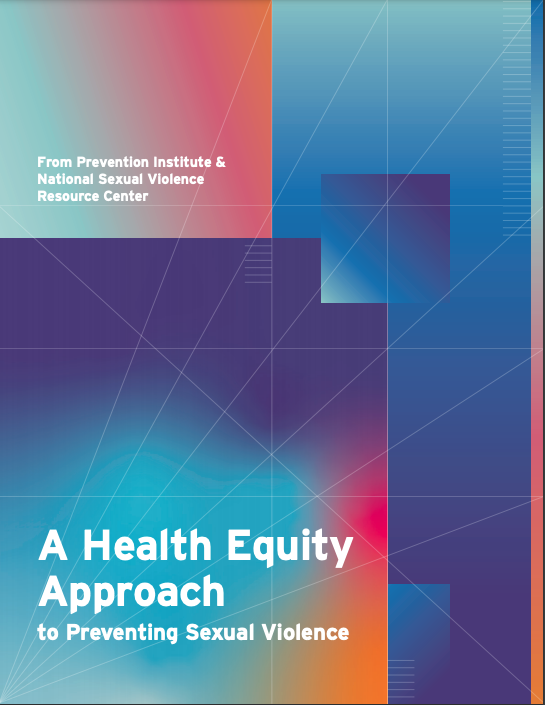Health Equity Approaches to Prevent Sexual Violence
Those working at the intersections of public health and sexual violence prevention may be familiar with the term health equity. But what are health equity approaches to preventing sexual violence? The National Sexual Violence Resource Center and Prevention Institute partnered on a new report, A Health Equity Approach to Preventing Sexual Violence. Read on for key takeaways from the report, and join us on August 24th for a web conference highlighting this report and some programs featured in it.
 What is a health equity approach to preventing sexual violence?
What is a health equity approach to preventing sexual violence?
Sexual violence prevention must address the root causes of violence such as oppression, systemic injustice, and historical and contemporary abuses of power. According to the National Sexual Violence Resource Center (2019), a health equity approach to preventing sexual violence “means that we need to both understand and address the factors that contribute to violence and safety and factors that expose some communities — especially communities that have been historically oppressed — to higher rates of sexual violence.” This requires grounding sexual violence prevention in anti-oppressive frameworks and centering the needs and strengths of the communities preventionists work within.
What are some ways people, organizations, and communities have begun to use a health equity approach to prevent sexual violence in their work?
The new report from the National Sexual Violence Resource Center and Prevention Institute highlights five themes within the ongoing work that uses a health equity approach to preventing sexual violence: 1) elevating community leadership and resilience; 2) creating spaces for healing in prevention efforts; 3) facilitating internal organizational change; 4) addressing underlying factors that contribute to violence and safety; and 5) partnering across fields and movements.
What are examples of health equity approaches to prevent sexual violence in action?
For each of the themes listed above, the National Sexual Violence Resource Center and Prevention Institute also dive into stories about health equity approaches to prevent sexual violence from organizations doing the work. Many of these stories and organizations have also been featured on PreventConnect, and are linked below.
- Elevating community leadership and resilience
- The New Jersey Department of Children and Families was featured on the PreventConnect web conference Engagement as a process and strategy: Strengthening connections and leadership opportunities to prevent sexual and intimate partner violence.
- Multicultural Efforts to End Sexual Assault (MESA) was featured on the PreventConnect web conference Culturally-Informed Prevention: Preventing sexual and domestic violence in communities of color.
- Creating spaces for healing in prevention efforts
- Visioning B.E.A.R. Circle Intertribal Coalition was featured on PreventConnect web conferences Evaluating Culturally-Relevant Sexual Violence Prevention Initiatives: Lessons learned with the Visioning B.E.A.R. Circle Intertribal Coalition Inc. Violence Prevention Curriculum, and Mobilizing and Organizing Communities to End Child Sexual Abuse: Lessons Learned from the Just Beginnings Collaborative, and presented at the 2018 National Sexual Assault Conference. PreventConnect will feature Visioning B.E.A.R. Circle Intertribal Coalition on an upcoming web conference, Walking in balance with all our relations: Leadership from and partnerships with Indigenous communities to end gender-based violence and restore wellbeing.
- Black Women’s Blueprint was featured on the PreventConnect web conference Toward Gender Equity: Supporting healthy masculinities for sexual and domestic violence prevention.
- Facilitating internal organizational change
- The Michigan Coalition to End Domestic and Sexual Violence will be featured on PreventConnect’s August 24th web conference Intersectional justice and safety from sexual violence: Spotlights from a new report on health equity strategies, and was featured on What Surrounds Us Shapes Us: Greening and other physical/built environment strategies for preventing domestic and sexual violence.
- The Oregon Coalition Against Domestic and Sexual Violence was featured on the PreventConnect web conference Culturally-Informed Prevention: Preventing sexual and domestic violence in communities of color.
- Addressing underlying factors that contribute to violence and safety
- The Colorado Department of Public Health was featured on PreventConnect web conferences Creating Protective Environments for LGBTQ+ Youth Within Schools and Communities to Prevent Sexual and Intimate Partner Violence, Participatory Action in Schools: Improving school climate and safety in K-12 schools for sexual and teen dating violence prevention, and Connecting the Dots: Understanding and Addressing the Links between Multiple Forms of Violence.
- The Alaska Network on Domestic Violence and Sexual Assault was featured on the PreventConnect web conference Getting Started on Supporting Economic Opportunity for Sexual and Domestic Violence Prevention.
- Partnering across fields and movements
- The Bloomington Inclusion Collaborative in Indiana was featured on the PreventConnect web conference A Safe Place to Call Home: Transforming the Physical/Built Environment for Sexual and Domestic Violence Prevention.
- One Fair Wage will be featured on PreventConnect’s August 24th web conference Intersectional justice and safety from sexual violence: Spotlights from a new report on health equity strategies.
Join us on August 24th, 2021 to learn more about A Health Equity Approach to Preventing Sexual Violence during our web conference with Prevention Institute and the National Sexual Violence Resource Center, Intersectional justice and safety from sexual violence: Spotlights from a new report on health equity strategies. Registration is still open for this opportunity to dive deeper into the report and hear from the people putting health equity approaches to preventing sexual violence in action.
